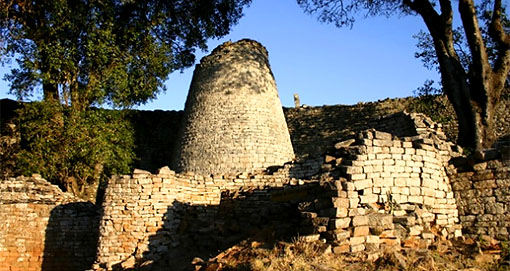Who built the great ruins of Zimbabwe? Was it King Solomon himself as Karl Mauch the German explorer claimed, or was it the Queen of Sheba? Archaeologists claim to have known the answer all along…
German explorer Karl Mauch asserted that the ruins of Zimbabwe was a copy of King Solomon’s Temple on Mount Moriah. It was 1871 and German romanticism was in full flower; the fine print of Heinrich Heine, not withstanding, Mauch deduced that local folklore about sacrificial rites at the ruins were close enough to the ancient Israelites and the lack of inscriptions and statues were consistent with Judaic monotheism and absence of idolatry. It was a wild leap, and a splendid notion, and among those impressed with it was H.Rider Haggard, who found in it the ingredients for King Solomon’s Mines (1885), one of the most widely read novels about Africa.

—Publicity still for King Solomon’s Mines. Stage, Cinema & S. A. Pictorial, 16 November 1918,—click image for source…
As word spread associating Zimbabwe with storied riches of the past, the ruins began attracting treasure hunters, who did immense damage there, and amateur antiquarians, who did even more. In those days, archaeology was more of a sport and pastime than a science, pursued by gentlemen of leisure- a bit similar to the wealthy blasting tigers with repeating rifles in India- who fanned out to promising sites all over the world, equipped with shovels, enthusiasm, and retinues of diggers, but with little or no idea of scientific procedure; which meant walls collapsed and foundations crumbled in a totally haphazard and random manner of excavation. During the last two decades of the nineteenth century, Zimbabwe was attacked by a good half dozen such parties. They dug at random and neglected to record what they had found or where they had found it. Since they were convinced that Zimbabwe was of ancient and august lineage, they threw out pots and artifacts of obviously native origin, even when these were unearthed at deep levels…( to be continued)…

—One of the highlights of a visit to Zimbabwe must be the ancient ruins at Great Zimbabwe which are located in the southern part of the country just outside the town of Masvingo.
The largest ancient stone construction south of the Sahara, Great Zimbabwe was built between the 12th and 15th centuries by the ancestors of the Shona, one of Zimbabwe’s many Bantu-speaking groups. Once the capital of the Kingdom of Zimbabwe, this settlement of approximately 12,000 people spanned a massive area of approximately 722 hectares (1,784 acres)—click image for source…
ADDENDUM:
(see link at end)…Josh Bernstein…Karl Mauch: “Mauch really made me appreciate just how far cultural perspectives and racism have changed over the years. How could one get away with saying ‘native Africans couldn’t have created these advanced structures?’ It’s astonishing. But then, I guess people say similar things today about the Atlantians and the Pyramids….. Hmmm. So maybe some things haven’t changed as much I’d like to think… But thank you, Gertrude Caton-Thompson for setting the record straight on Great Zimbabwe!”…
… “I’ve never been to Zimbabwe before, but I have been to other parts of Africa and I always enjoy the savannah, where monkeys swing in the trees. I’m impressed at the journey that Solomon’s sailors would had to have made to get here (if it was here) both by sea and by land. Not easy, to say the least, but a king’s order and the promise of untold riches would be a good motivator for many, I’m sure. To have spent weeks at sea and then have to trek in from the shore through unknown jungles of wild animals..
…Great Zimbabwe: “The hills, the stones, the curves of the walls…what a great place! And the place just keeps on going, well into the surrounding countryside. Whoever lived here, they must have been a powerful people with an impressive knowledge of stonework. Edward’s a fun guy for my tour, but with his rapid speech and strong accent, it takes me about 10 minutes to figure out how to listen to him properly (stick with it!). Once I get the hang of it, though, I’m amazed at the conclusions Karl Mauch jumped to.” Read More:http://diggingforthetruth.net/season1episode6.html





 COMMENTS
COMMENTS